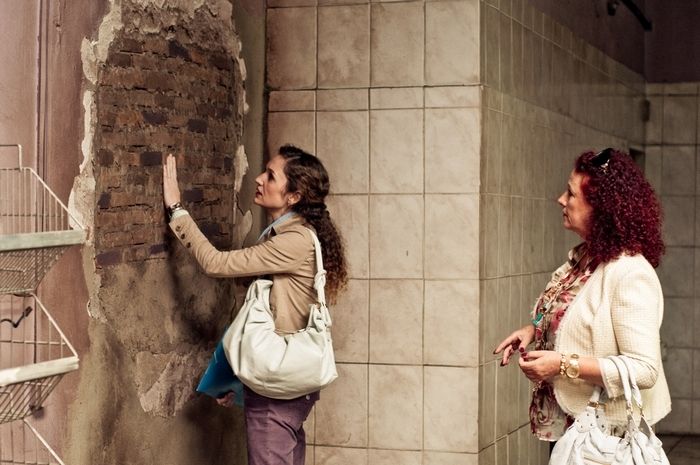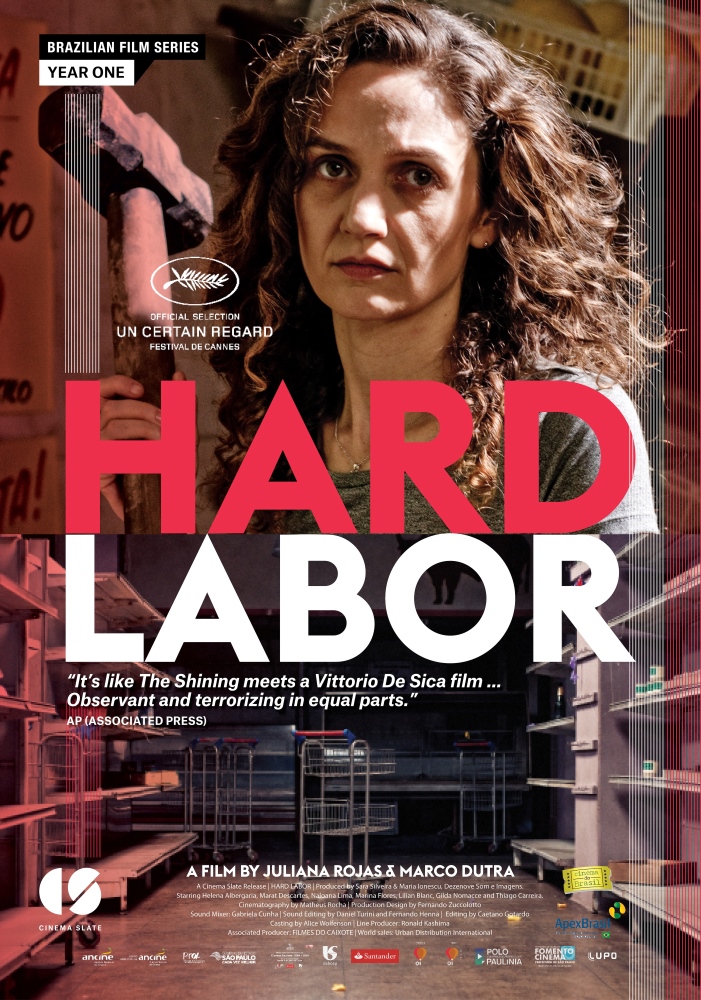(Trabalhar Cansa)
Brazil. 2011.
Crew
Directors/Screenplay – Marco Dutra & Juliana Rojas, Producer – Sara Silveira, Photography – Matheus Rocha, Music – Rafael Cavalcanti, Production Design – Fernando Zuccolotto. Production Company – Films do Caixote/Dezenove Sons e Imagens.
Cast
Helena Albergaria (Helena), Marat Descartes (Otavio), Naloana Lima (Paula), Lilian Blanc (Ines), Gilda Nomacce (Gilda), Thiago Carriera (Ricardo), Marina Flores (Vanessa)
Plot
In Sao Paulo, Helena looks over an old supermarket and decides she wants to take out a lease and reopen it. She returns home to find that her husband Otavio has been laid off from work. They decide to go ahead and open the supermarket anyway. She hires staff, as well as a live-in maid/babysitter Paula for their young daughter. With the store open, Helena struggles and stresses, obsessing over supplies that seem to be going missing. This makes her become increasingly paranoid, believing that one member of staff is stealing them. There is also a mysteriously growing damp spot on the wall, black ichor oozing from underneath the floor tiles and something moving about in the store after dark. Meanwhile, facing the prospect of long-term unemployment, Otavio sinks into depression.
This is an interestingly odd Brazilian film that turned up at the Vancouver International Film Festival. On one level, Hard Labor seems to want to be a ghost story. The supermarket seems to be a classic Bad Place exuding evil of some kind – a foul-smelling black substance seeps out of the floor, there is a growing patch of rot on one of the walls, supplies go mysteriously missing, something appears to be moving in the aisles at night even though nobody is there, the building has an ominous past including the previous owner’s wife having reportedly gone mad, while the skeleton of some type of unknown animal/creature is found buried inside the wall.
More than anything, just like The Shining (1980) and in particular The Amityville Horror (1979) to which Hard Labor has undeniable resemblances, the building seems to infect people with its malevolence – Helena Albergaria’s blandly anonymous look at the start becomes increasingly harsher and more drawn as she accuses her employees of theft, pressures them to work longer hours and obsesses over missing supplies, while her husband (Marat Descartes) seems to sink deeper and deeper into depression after being laid off from work.
All of this would seem to be highly promising material for a ghost story. Certainly, while we have had everything from haunted hotels – The Shining, haunted hotel rooms – 1408 (2007), haunted hospitals – The Kingdom (1994), haunted prisons – Prison (1987), haunted submarines – Below (2002) and Ghostboat (2006), haunted vehicles – The Wraith (1986), haunted airplanes – The Horror at 37,000 Feet (1973), haunted drive-in theatres – Ruby (1977), haunted videotapes – The Ring (2002), the supermarket is a location that nobody has tried yet as far as I am aware – although we did have a supermarket slasher film with Intruder (1989).

That said, despite being primed, Hard Labor refuses to conform to any of the tropes of the haunted house genre. Directors Marco Dutra and Juliana Rojas never engage in any atmosphere generating tactics and seem disinterested in ever attempting to scare us; the film is directed with a plain middle of the road approach the entire way. Even more so, Hard Labor is a ghost story that comes without any resolution. There is no explanation of what the creature in the wall is, if it or anything else in the building is influencing people or if the changes in Helena Albergaria’s behaviour are just general financial and psychological stress. The story comes to a frustratingly abrupt non-ending with Marat Descartes in a motivational seminar that ends on a freeze-frame of his face as he breaks into a primal scream.
On another level, Hard Labor has been made as a metaphor for the effects of the current recession. Marco Dutra and Juliana Rojas set out to depict the effect that this has had on all strata of society – Helena Albergaria represents the independent small business owner and the stress that they are experiencing in trying to make financial ends meet; Marat Descartes is representative of middle-aged middle-management suddenly being faced with redundancy and a shrinking job market; while Naloana Lima’s maid represents the underclass of people on the margins as she searches for registration (some facet of Brazilian labour law that was not clear to me, which I gather is akin to getting a legal work permit) and is forced to accept tough job conditions, including a month’s trial without pay, in order to become employed. This is something that Hard Labor does a fair job of portraying. However, in trying to be a ghost story as well, it becomes an unsatisfying morass of confusing and unresolved plotting ends.
Subsequently, both separately, Juliana Rojas went onto make Necropolis Symphony (2014), a surreal comedy about a gravedigger, while Marco Dutra went onto make the ghost story When I Was Alive (2014) and The Silence of the Sky (2016)., before two reteamed for the horror film Good Manners (2017)
Trailer here


